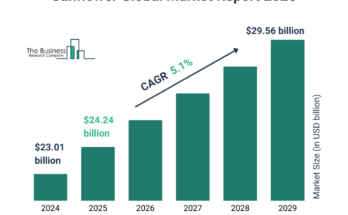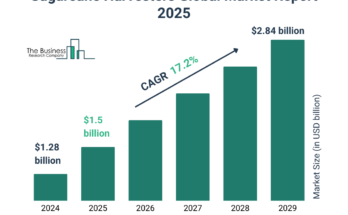Overview and Scope
Low-light imaging refers to night vision imaging or night vision cameras. Low-light imaging has been used in numerous scientific domains, including astronomy, fluorescence, and luminescence applications.
Sizing and Forecast
The low light imaging market size has grown rapidly in recent years. It will grow from $13.78 billion in 2023 to $15.41 billion in 2024 at a compound annual growth rate (CAGR) of 11.9%. The growth in the historic period can be attributed to demand for surveillance and security solutions, expansion of wildlife monitoring, increase in consumer photography demands, increased applications in medical imaging, expansion of industrial inspection..
The low light imaging market size is expected to see rapid growth in the next few years. It will grow to $24.28 billion in 2028 at a compound annual growth rate (CAGR) of 12.0%. The growth in the forecast period can be attributed to integration in autonomous vehicles, development of wearable cameras, enhanced integration in smartphones, expansion of smart city initiatives, demand for consumer electronics with night mode.. Major trends in the forecast period include technological convergence with ai, advancements in image sensor technology, time-of-flight (tof) cameras, miniaturization and integration, technological progress in image processing..
To access more details regarding this report, visit the link:
https://www.thebusinessresearchcompany.com/report/low-light-imaging-global-market-report
Segmentation & Regional Insights
The low light imaging market covered in this report is segmented –
1) By Technology: Complementary Metal-Oxide Semiconductor (CMOS), Charge-Coupled Device (CCD)
2) By Application: Photography, Monitoring, Inspection And Detection, Security and Surveillance
3) By Vertical: Consumer Electronics, Automotive, Medical And Life Sciences, Military And Defense, Industrial, Commercial And Residential Infrastructure
Asia-Pacific was the largest region in the low-light imaging market in 2023. Asia-Pacific is expected to be the fastest-growing region in the low light imaging market during the forecast period. The regions covered in the low light imaging market report are Asia-Pacific, Western Europe, Eastern Europe, North America, South America, Middle East, Africa
Intrigued to explore the contents? Secure your hands-on sample copy of the report:
https://www.thebusinessresearchcompany.com/sample.aspx?id=9089&type=smp
Major Driver Impacting Market Growth
The rapid adoption of advanced driver assistance systems (ADAS) for automobiles is expected to boost the growth of the low-light imaging market going forward. Advanced driver-assistance systems (ADAS) refer to electronic components in vehicles that support the driver by utilizing cutting-edge technologies. To keep up with the rising requirements for vehicle safety, Advanced Driver Assistance Systems (ADAS) need low-light image sensors with improved capability, so rapid adoption of ADAS is boosting the low-light imaging market. For instance, according to a report published by Autoglass® & Allglass, a UK-based leading vehicle glass repair and replacement service, in 2022, nearly 85% of all vehicles built worldwide will have some form of automated driving by 2025. Therefore, the rapid adoption of advanced driver assistance systems (ADAS) for automobiles is driving the growth of the low-light imaging market.
Key Industry Players
Major companies operating in the low-light imaging market are increasing their focus on introducing innovative low-light navigation cameras to gain a competitive edge in the market. A low-light navigation camera is a specialized imaging device designed to capture clear and detailed visuals in low-light or nighttime conditions, providing enhanced visibility for navigation purposes, particularly in vehicles, drones, or other autonomous systems. For instance, in March 2022, Immervision, a Canada-based camera company, launched a UAV low-light navigation camera module that features a wide-angle panomorph lens with smart pixel management, providing enhanced image quality and high performance in low-light conditions, allowing secure navigation. The camera module has a 5-MPixel sensor and an MIPI interface, weighs only 4.7 grams, and is integrated with the Qualcomm platform, making it broadly available to drone and robotics manufacturers.
The low light imaging market report table of contents includes:
- Executive Summary
- Low Light Imaging Market Characteristics
- Low Light Imaging Market Trends And Strategies
- Low Light Imaging Market – Macro Economic Scenario
- Global Low Light Imaging Market Size and Growth
.
.
.
- Global Low Light Imaging Market Competitive Benchmarking
- Global Low Light Imaging Market Competitive Dashboard
- Key Mergers And Acquisitions In The Low Light Imaging Market
- Low Light Imaging Market Future Outlook and Potential Analysis
- Appendix
Contact Us:
The Business Research Company
Europe: +44 207 1930 708
Asia: +91 88972 63534
Americas: +1 315 623 0293
Email: info@tbrc.info
Follow Us On:
LinkedIn: https://in.linkedin.com/company/the-business-research-company
Twitter: https://twitter.com/tbrc_info
Facebook: https://www.facebook.com/TheBusinessResearchCompany
YouTube: https://www.youtube.com/channel/UC24_fI0rV8cR5DxlCpgmyFQ
Blog: https://blog.tbrc.info/
Healthcare Blog: https://healthcareresearchreports.com/
Global Market Model: https://www.thebusinessresearchcompany.com/global-market-model




